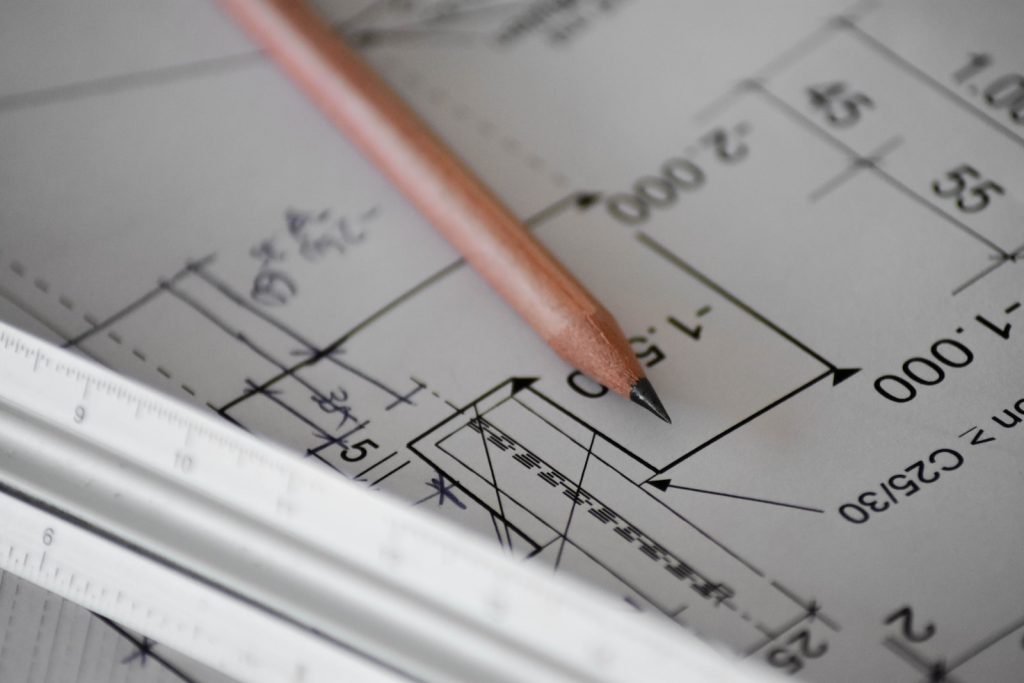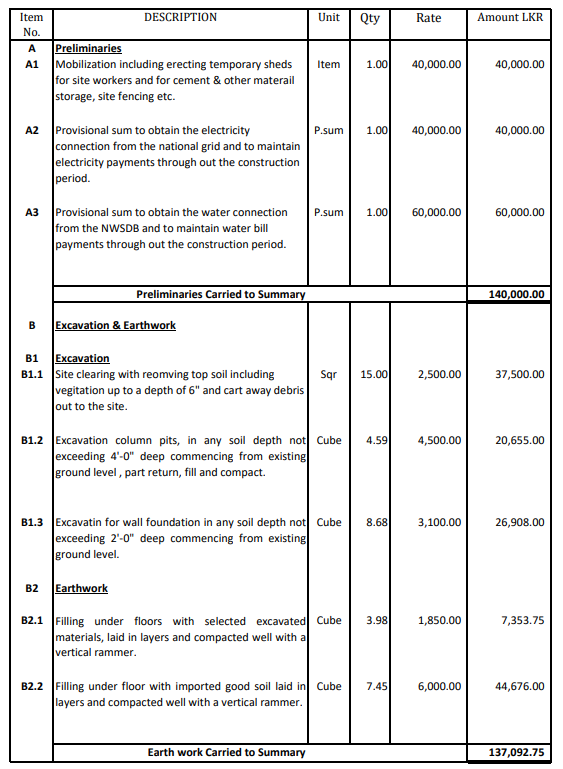Introduction
Construction projects are complex endeavors that require meticulous planning, precise execution, and efficient management. One of the crucial aspects of any construction project is accurate cost estimation. Without a clear understanding of the project’s scope and the associated costs, it becomes challenging to ensure the project’s success within budgetary constraints. This is where a Bill of Quantities (BOQ) plays a pivotal role. In this article, we will delve into the BOQ meaning and significance of BOQ in construction projects, exploring its purpose, standards, challenges, and future trends. So, let’s embark on this journey to unravel the mysteries of BOQ.
BQ / BOQ Meaning
BQ or BOQ Meaning is Bills of Quantity. At its core, a Bill of Quantities (BOQ) is a document that provides project-specific measured quantities of the items identified in drawings and specifications for a built asset, such as a building. It is typically prepared by a cost consultant, such as a quantity surveyor, and serves as a comprehensive inventory of the materials, components, and work activities required for the construction project.
To create a BOQ, the design must be complete, and a specification should be prepared. The quantities listed in a BOQ can be measured in terms of number, length, area, volume, weight, or time, depending on the specific requirements of the project. It is worth noting that BOQs are generally prepared for larger projects, while on smaller projects or alteration works, suppliers may measure their own quantities from drawings and schedules of work.
Now that we understand the essence of a BOQ, let’s explore its purpose and how it contributes to the success of construction projects.

The Purpose of a Bill of Quantities
The primary purpose of a BOQ is to facilitate accurate cost estimation and ensure consistency in tendering processes. When a construction project enters the tender stage, the BOQ is included in the documentation issued to prospective suppliers. It enables tenderers to calculate construction costs based on the quantities specified in the BOQ.
By providing a standardized set of quantities for all tenderers, the BOQ creates a fair and accurate system for tendering, allowing for easy comparison of different tenders.
Suppliers tender against the BOQ by stating their prices for each item, and this priced bill of quantities forms their offer. The uniformity of the quantities allows for a detailed assessment of tender offers, enabling effective tender negotiations.
Furthermore, the priced bill of quantities assists in the agreement of the contract sum, valuation of variations, interim payments, and preparation of the final account.
With the purpose of BOQs established, let’s explore the standards and methodologies used in creating these crucial documents.
Types of BOQ in Use in the Construction Industry
- Approximate Bill of Quantities
- Firm Bill of Quantities
Approximate Bill of Quantities
- Approximate Bill of Quantities utilized for remeasurement contracts.
- it is crucial to acknowledge that while the measured quantities are approximations, the descriptions of work items should not be amended in the approximate bill of quantities.
Firm Bill of Quantities
- In the context of a Firm Bill of Quantities, which is employed to determine a lump-sum price for a fully designed project
- It is important to note that if there are no variations or claims
- The initial Contract Value will equal the final Contract Sum upon the project’s completion.
BOQ Example Page / BOQ Format
6 main components/columns of a BOQ are to be considered as follows:
- Item No
- Item Description
- Unit of the Item
- Unit Rate
- Total Amount

Major Sections/ Parts of a Standard BOQ
In a Startdard BOQ following sections are included.
- Preliminaries
- Daywork Schedule
- Provisional Sum
- Measured Works
- List of Principle Quantities
- Pricing Preambles
- Rate Breakdown of each BOQ item
Measured Work Sections
- Excavation & Earth Work (Foundation Including Ground Slab)
- Concrete Work
- Masonry Work (Brick Work & Rubble Work)
- Roof And Roof Plumbing
- Waterproofing And Termite Treatment
- Metal Work
- Carpentry And Joinery Works
- Finishes (Floor, Wall Ceiling Finishes Including Plastering)
- Painting And Decorations
- Plumbing And Sanitary Installation
- Air Conditioning And Ventilation
- Electrical Installation
- Safety & Security System Installation
What is the purpose of a List of Principal Quantities?
To facilitate the tenderers in swiftly evaluating the scope of work, a comprehensive list of the main components of the project, along with their estimated quantities, will be provided.
Upon receiving a tender, the contracting firm can quickly review the List of Principal Quantities, gaining a preliminary understanding of the project. Subsequently, taking into account factors such as resource availability, existing workload, financial considerations, and other constraints, the firm will determine whether to submit a bid for the specific project.
If the management decides to pursue the opportunity, the tendering department will meticulously examine the detailed Bill of Quantities (BOQ), which may consist of thousands of pages, along with other pertinent contract documents, to ensure accurate pricing.
Standards for Bills of Quantities
There are several widely used Standard Methods of Measurement (SMM) documents in the construction industry that help establish consistent measurement practices. These include:
POMI (Principles of Measurement International For Works of Construction – JUNE 1979)
SMM7 (Standard Method of Measurement 7th Edition)
- Designed for Building Projects
- Published by RICS (Royal Institution of Chartered Surveyors)
- Although it is no longer in use, SMM7 was known for its comprehensive and highly detailed measurement rules. However, its complexity often resulted in longer measurement times.
- SMM7 has been replaced by the New Rules of Measurement (NRM).
- Download the SMM7
NRM (New Rules of Measurement)
- Developed for Building Projects
- Published by RICS
- NRM consists of multiple parts:
- NRM 1: Used for Cost Planning Purposes
- NRM 2: Intended for Detailed Measurement, serving as a replacement for SMM7
- NRM 3: Specifically designed for Rehabilitation and Maintenance Works
- Download the latest edition of NRM
CESMM (Civil Engineering Standard Method of Measurement)
- Tailored for Infrastructure/Civil Engineering Projects
- Published by the Institution of Civil Engineers, UK (ICE)
- The latest edition is CESMM 4, which has replaced CESMM 3.
To ensure clarity, consistency, and uniformity, it is essential to prepare bills of quantities according to standardized methodologies. In the United Kingdom, bills of quantities for general construction works were traditionally prepared in accordance with the Standard Method of Measurement 7th Edition (SMM7). However, the New Rules of Measurement (NRM) superseded SMM7 in 2013, introducing a more contemporary framework for preparing BOQs.
SMM7 incorporated the Common Arrangement of Work Sections (CAWS), a standard method for categorizing works. The categorization system used in CAWS was also adopted by the National Building Specification (NBS). However, with the advent of NRM, changes occurred, and CAWS was integrated into Uniclass, a classification system used in construction. Additionally, NRM introduced its own system of indexing, departing from CAWS. For civil engineering works, the Civil Engineering Method of Measurement (CESMM) is commonly used.
It is crucial for quantity surveyors and cost consultants to adhere to these standardized methods of measurement to avoid disputes arising from different interpretations and ensure accurate pricing and tendering processes.
The Purpose of the Standard Method of Measurements
The standard method of measurement serves a crucial purpose in the construction industry. It aims to establish consistent measurement principles that are universally adopted by all parties involved in contracts. By adhering to a standard method, it ensures that bidders can accurately price the works in alignment with the employers’ requirements. This consistency helps prevent disputes that may arise during the post-contract stage regarding the valuation of the completed work.
The standard method of measurement not only describes the methodology of measurement but also specifies the inclusion and exclusion of cost components within a work item. This comprehensive framework provides clarity and transparency, allowing for a fair evaluation of the project’s progress and the associated costs.
By promoting consistency and uniformity in measurement practices, the standard method of measurement facilitates smoother contractual processes, minimizes disputes, and enhances overall industry efficiency.
Now that we understand the standards, let’s uncover the process of creating a bill of quantities.
How to Create a Bill of Quantities
The process of creating a bill of quantities involves a methodical approach to accurately quantify the materials and work activities required for a construction project. Here are the key steps in creating a BOQ:
- Review the design: Begin by thoroughly reviewing the design drawings and specifications to gain a clear understanding of the project’s scope and requirements.
- Identify and measure items: Identify all the relevant items, components, and work activities required for the project. Measure the quantities using appropriate units and measurement techniques as per the standard method of measurement.
- Organize the BOQ: Structure the BOQ in a logical and systematic manner, grouping items according to relevant work sections or packages. This facilitates easy understanding and pricing by suppliers.
- Price the BOQ: Assign prices to each item in the BOQ. Suppliers will use these prices to calculate their tender costs. Ensure the pricing is accurate, competitive, and in line with market rates.
- Review and finalize: Review the BOQ to verify accuracy, completeness, and consistency. Collaborate with the project team and stakeholders to address any queries or discrepancies. Once finalized, the BOQ becomes an integral part of the tender documentation.
By following these steps, quantity surveyors can create a comprehensive and well-structured BOQ that serves as a foundation for accurate cost estimation and tendering processes.
Having explored the process of creating a BOQ, let’s now delve into the benefits and common uses of these vital documents.
Benefits of Using a Bill of Quantities
The utilization of a bill of quantities offers several benefits to construction projects. Let’s take a closer look at some of the key advantages:
- Accurate cost estimation: A BOQ provides a detailed breakdown of quantities and prices, enabling precise cost estimation. This helps in budget planning, resource allocation, and overall financial management of the project.
- Fair and transparent tendering: By using a standardized BOQ, all tenderers have access to the same set of quantities, ensuring fair and transparent tendering processes. This promotes healthy competition and helps in selecting the most suitable supplier.
- Comparative analysis: The structured format of a BOQ allows for easy comparison of tender offers. It enables the client to assess different aspects of each tender and make informed decisions based on value for money and specific requirements.
- Effective contract management: The BOQ serves as a contractual document that helps in managing variations, interim payments, and the final account. It provides a clear reference point for measuring work progress and valuing the completed works.
- Enhanced project control: A well-prepared BOQ improves project control by providing a comprehensive inventory of materials and work activities. It helps in tracking progress, identifying potential bottlenecks, and ensuring timely completion of the project.
These benefits highlight the instrumental role that a bill of quantities plays in streamlining construction projects, mitigating risks, and promoting project success.
While we have explored the advantages, it is important to acknowledge the challenges that come with preparing a bill of quantities. Let’s uncover these challenges and discover tips to overcome them.
Challenges in Preparing a Bill of Quantities
The process of preparing a bill of quantities is not without its challenges. Quantity surveyors and cost consultants often encounter the following hurdles:
- Incomplete or ambiguous designs: Inaccurate or incomplete design information can make it challenging to identify and quantify all the required items accurately. Close collaboration with the design team is crucial to resolve ambiguities and ensure completeness.
- Limited availability of information: Availability of comprehensive and reliable information, such as drawings and specifications, can vary during the early stages of a project. Quantity surveyors must proactively gather relevant data and seek clarifications to avoid any gaps in the BOQ.
- Complexity and scope changes: Construction projects can be complex, involving numerous interrelated components and frequent scope changes. Managing these complexities and incorporating changes into the BOQ require diligent tracking and effective communication.
- Time constraints: Preparing a detailed and accurate BOQ demands time and effort. Quantity surveyors often face tight project schedules, leaving limited time for comprehensive measurement and pricing. Efficient time management and prioritization are essential to meet deadlines.
- Variations and unforeseen circumstances: During construction, variations and unforeseen circumstances can arise, affecting the accuracy and completeness of the original BOQ. Quantity surveyors must be adaptable and responsive to accommodate these changes and maintain accurate records.
To overcome these challenges, quantity surveyors can adopt certain strategies:
- Early involvement: Engage with the project team and stakeholders at the early stages to ensure a clear understanding of project requirements and avoid design-related issues.
- Thorough documentation: Maintain meticulous documentation of all design changes, clarifications, and variations to keep the BOQ updated and reflective of the project’s evolving scope.
- Continuous coordination: Maintain open lines of communication with the design team, suppliers, and contractors throughout the project lifecycle to address queries, clarify specifications, and resolve ambiguities promptly.
- Utilize technology: Leverage specialized software and digital tools for BOQ preparation and management. These tools can automate certain tasks, enhance accuracy, and streamline the overall process.
- Regular reviews: Conduct regular reviews and audits of the BOQ to identify any discrepancies, inconsistencies, or omissions. Timely rectification minimizes the chances of errors and mitigates potential disputes.
By employing these strategies, quantity surveyors can navigate the challenges and deliver accurate and comprehensive bills of quantities that contribute to the success of construction projects.
Now that we have explored the challenges and strategies for overcoming them, let’s draw a comparison between a bill of quantities and a bill of materials (BOM) to understand their differences and applications.
BOQ vs. BOM: Key Differences
While both a bill of quantities (BOQ) and a bill of materials (BOM) are essential documents in construction projects, they serve distinct purposes and differ in their scope. Let’s examine the key differences between the two:
- Purpose: A BOQ primarily focuses on quantifying and pricing the materials, components, and work activities required for a construction project. It facilitates accurate cost estimation, tendering, and contract management. On the other hand, a BOM provides a detailed list of materials and components necessary for the construction or manufacturing of a specific product.
- Level of detail: A BOQ provides a more detailed breakdown of quantities, units of measurement, and prices for each item. It enables suppliers to accurately price their tenders and assists in project cost control. In contrast, a BOM focuses on the specific materials and components required, often including specifications, part numbers, and quantities, but typically without pricing details.
- Application: A BOQ is primarily used in the construction industry for various types of projects, such as buildings, infrastructure, and civil engineering works. It serves as a contractual and financial document. Conversely, a BOM is commonly used in manufacturing and production processes to ensure the availability and proper ordering of materials for assembling products.
- Audience: The primary audience for a BOQ is the construction industry professionals involved in estimating, tendering, and project management. It is shared with potential suppliers and forms the basis for contract negotiations. In contrast, a BOM is primarily used by manufacturing and production teams to guide the procurement and assembly of materials for creating a product.
While there are similarities between a BOQ and a BOM in terms of listing materials and components, their respective purposes, levels of detail, applications, and target audiences set them apart.
As we conclude our exploration of BOQs, let’s take a glimpse into the future and consider the potential trends and advancements in this field.
Future Trends in Bill of Quantities
The construction industry is continually evolving, adopting new technologies and methodologies to enhance efficiency and productivity. Here are some potential future trends in the field of the bill of quantities:
- Digitalization and BIM integration: The increasing adoption of Building Information Modeling (BIM) is likely to impact the preparation and utilization of BOQs. BIM integration can streamline quantity takeoff processes, improve accuracy, and enable real-time synchronization between the BOQ and the 3D model, facilitating better project control.
- Automation and AI: Advancements in automation and artificial intelligence (AI) can automate repetitive tasks involved in BOQ preparation, such as quantity measurement and pricing. AI algorithms can analyze historical data to provide more accurate cost estimates and identify patterns or discrepancies in the BOQ.
- Standardization and interoperability: Efforts towards standardizing measurement methods and classification systems, such as Uniclass and the International Construction Measurement Standards (ICMS), are expected to continue. Improved interoperability between software platforms and data exchange formats will enhance collaboration and data consistency across project stakeholders.
- Integration with cost estimating software: Integration of BOQs with cost estimating software and project management tools can streamline workflows, improve accuracy, and enable seamless data transfer between different project phases.
- Sustainability considerations: As sustainability becomes a central focus in the construction industry, future BOQs may include additional information related to green materials, energy-efficient solutions, and environmental impact assessments.
These trends indicate a shift towards digitalization, automation, and improved collaboration in the preparation and utilization of BOQs, aiming to enhance project efficiency, accuracy, and sustainability.
Conclusion
BOQ Meaning: A Bill of Quantities (BOQ) plays a critical role in construction projects by providing a detailed inventory of quantities and prices for materials, components, and work activities. It facilitates accurate cost estimation, fair tendering processes, and effective contract management. Despite the challenges involved in BOQ preparation, strategies such as early involvement, thorough documentation, continuous coordination, technological adoption, and regular reviews can help overcome these obstacles.
Distinct from a Bill of Materials (BOM), a BOQ serves the construction industry and focuses on project-specific requirements, while a BOM is used in manufacturing and product assembly. The future of BOQs lies in digitalization, BIM integration, automation, standardization, and sustainability considerations. By embracing these trends, the construction industry can streamline processes, enhance accuracy, and achieve greater project success.







